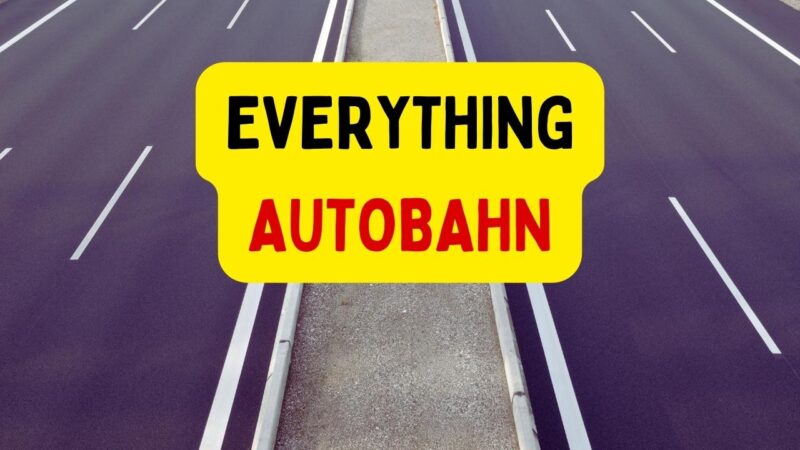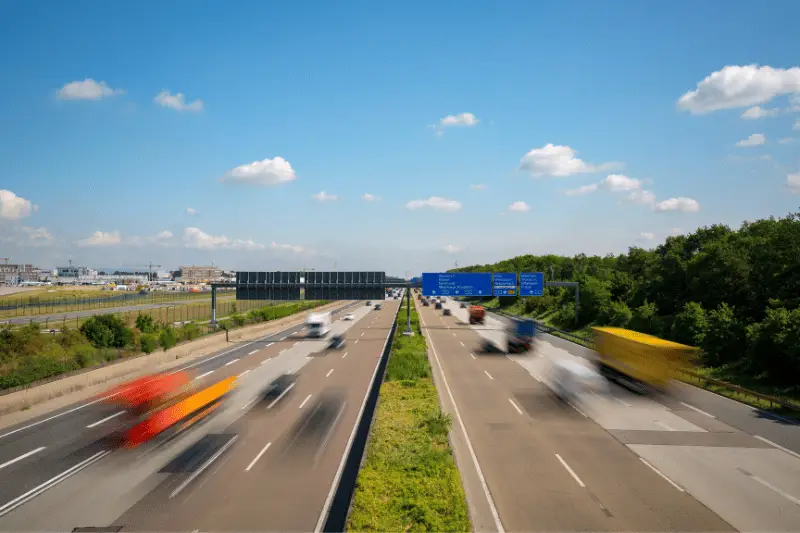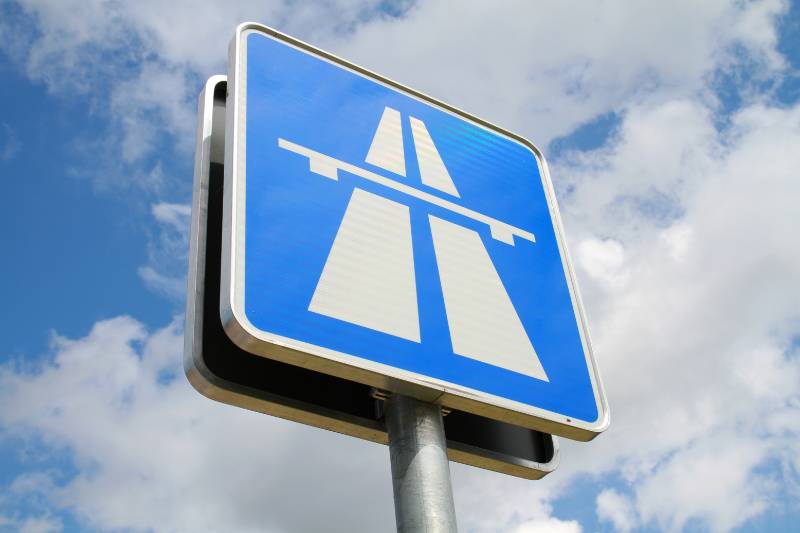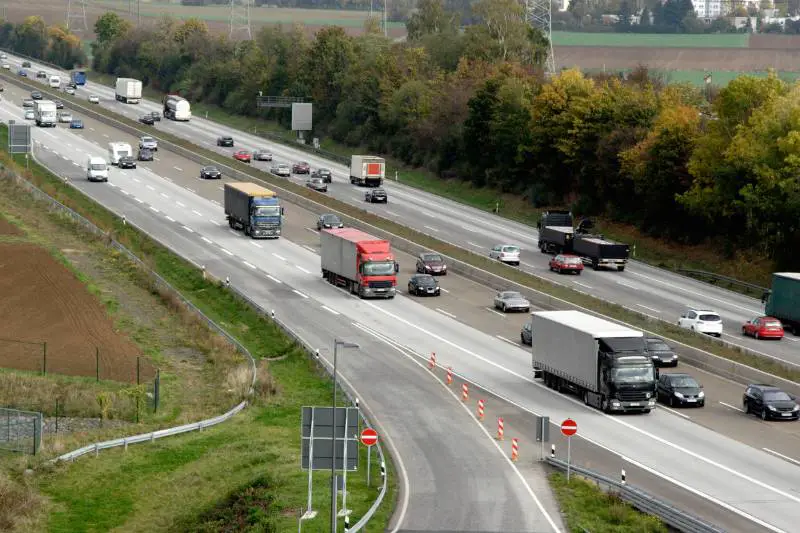In this article, we’ll take a journey through everything you need to know about the German Autobahn, from its fascinating history to its role in modern society.
I want to share with you what makes the Autobahn a unique and iconic highway system that captures the imagination of millions, perhaps billions, across the globe. Famous for its stretches without speed limits, the Autobahn is actually much more than just a high-speed paradise.

We’ll explore its advanced infrastructure and meticulous safety features, discuss its economic and environmental impact, and delve into the cultural significance it holds in Germany.
Whether you’re curious about its engineering marvels or intrigued by the ongoing debates about its future, this article will guide you through the complexities in a way that’s easy to understand and engaging. Join me as we buckle up and navigate the world of the German Autobahn.
Love Germany? Click here to download your free guide to 25 Incredible Things You Must Do In Germany In Your Lifetime. You won’t want to miss them!
Introduction to the German Autobahn
When you think of the German Autobahn, the first thing that might come to mind is its legendary stretches without speed limits. It’s a symbol of freedom and engineering marvel. But there’s more to this iconic highway system than just fast cars and open roads.
The Autobahn dates back to the early 20th century and has a rich history. It was initially conceived as a means to boost the economy and improve transportation. Over the years, it has evolved into a complex network spanning thousands of kilometers across Germany.
Unique characteristics set the Autobahn apart from other highways. The most famous is that certain sections have no speed limit, a concept almost mythical to many drivers. But did you know that not all parts of the Autobahn allow unlimited speeds? Many sections have regulated limits for safety.
Safety is a priority on the Autobahn, even in speed-limit-free zones. There are strict rules and advanced monitoring systems to ensure traffic flows smoothly and safely. The Autobahn is designed with multiple lanes, no intersections, and emergency lanes to handle high-speed traffic effectively.
Understanding the German Autobahn gives you a glimpse into Germany’s dedication to innovation and infrastructure. It’s not just a highway but a testament to progressive engineering and meticulous planning. As you drive on it, you’re part of a legacy that continues to evolve and fascinate.

The Myth and Reality of No Speed Limits
You’ve likely heard tales of zooming across the Autobahn at any speed you desire. While it’s true that sections of the Autobahn have no speed limit, this isn’t the whole story. In reality, about 30% of the Autobahn network has a speed limit of 130km/h and there are other restrictions too.
Speed limits are imposed in specific areas for safety reasons. You’ll find them near cities, in construction zones, and in areas prone to traffic jams. These limits are strictly enforced, so it’s essential to pay attention to road signs indicating speed changes.
Safety on the Autobahn goes beyond just speed limits. Germany has implemented rigorous safety measures, including regular patrols, frequent maintenance, and state-of-the-art monitoring systems. Drivers are also expected to follow stringent rules, like maintaining a safe following distance and always using the right lane unless overtaking.
Infrastructure and Design
The German Autobahn is renowned for its superior infrastructure and design. It is meticulously planned and built to handle high-speed travel effectively. From its multiple lanes to its smooth asphalt surfaces, every detail is engineered for safety and efficiency.
The construction of the Autobahn involves advanced engineering techniques. Roads are designed with varying layers of materials to ensure durability and resilience. Bridges, tunnels, and overpasses are built to withstand heavy traffic and extreme weather conditions.
Maintenance and modernization are ongoing processes. The German government invests significantly in keeping the Autobahn in top condition. Regular updates include resurfacing roads, upgrading signage, and enhancing emergency response systems. This continuous effort ensures that the Autobahn remains one of the world’s premier highway systems.
Economic Impact
The Autobahn is not just a marvel of engineering but also a vital economic asset. It plays a significant role in facilitating commerce and trade throughout Germany and Europe. Efficient transportation of goods and people contributes directly to the economy’s dynamism.
Businesses rely on the Autobahn for quick and reliable logistical operations. The ability to move products swiftly across regions minimizes delays and enhances productivity. Additionally, the Autobahn attracts tourism, further bolstering local economies.
However, maintaining such an extensive network incurs substantial costs. Funding for construction and upkeep involves both public and private investments. Despite these expenses, the economic benefits derived from the Autobahn far outweigh the costs, making it an indispensable component of Germany’s infrastructure.

Environmental Considerations
While the Autobahn is famed for unrestricted driving, it also raises environmental concerns. High-speed travel and heavy traffic contribute to emissions and noise pollution. These factors necessitate a constant balancing act between progress and environmental responsibility.
Germany is proactive in addressing these issues. There are ongoing initiatives to reduce the Autobahn’s environmental impact, such as promoting electric vehicles and developing eco-friendly road materials. Additionally, regulations aim to minimize the ecological footprint by implementing emission standards and noise barriers.
The future of the Autobahn likely includes even more green technology. Advances in fuel efficiency, alternative energy sources, and smart traffic management are part of an evolving strategy. This way, the Autobahn can continue to be a leader in both transportation and environmental stewardship.
Comparisons with Other Highways Worldwide
The German Autobahn often stands in stark contrast to other major highways around the world. Its design, regulations, and engineering standards set it apart from many international counterparts. Understanding these differences can offer unique insights into global transportation systems.
Highways in the United States, for example, typically have lower speed limits and different safety protocols. While American highways cover vast distances, traffic management and road conditions vary significantly. European neighbors like France and Italy also have highly developed motorway systems but with stricter speed regulations.
Learning from the Autobahn, other countries can adopt best practices in road safety, maintenance, and design. Conversely, Germany can also benefit from international innovations. Such exchanges help improve global transportation networks, making travel safer and more efficient for everyone.
Driving Experience on the Autobahn
Driving on the Autobahn is a unique and exhilarating experience. The smooth, well-maintained roads and the ability to drive at high speeds in certain sections create a sense of freedom unparalleled by many other highways. However, this experience comes with its own set of rules and expectations.
As a driver, it’s crucial to understand and follow these rules. For instance, always stay in the right lane unless overtaking, and remember to check your mirrors frequently. The left lane is strictly for passing, and slower vehicles must move aside promptly to allow faster traffic through.
For tourists and international drivers, preparation is key. Familiarize yourself with German road signs and driving customs. It’s also wise to rent a car designed for high-speed driving to fully enjoy the Autobahn safely. With the right preparation, your journey can be both thrilling and safe.
You can find our full guide to driving in Germany here.

The Role of Technology
Technology plays a significant role in the functionality and safety of the Autobahn. Advanced traffic management systems monitor flow and help prevent congestion. These systems use sensors and cameras to provide real-time data, ensuring efficient traffic movement.
Navigation systems also enhance the driving experience. Modern GPS devices in vehicles offer up-to-date information on traffic conditions, speed limits, and roadworks. This technology helps drivers make informed decisions, reducing the risk of accidents and delays.
Looking to the future, autonomous driving technologies are being tested and gradually implemented. These advancements promise to revolutionize the way we use the Autobahn. Self-driving cars could greatly improve safety, reduce traffic jams, and even make long-distance travel more comfortable and efficient.
Autobahn Accidents and Safety
Despite the allure of high-speed travel, safety on the Autobahn is a serious concern. Accidents can occur, and their consequences are often severe, given the high speeds involved. However, Germany’s stringent safety measures significantly mitigate these risks.
One key element is the robust emergency response system. Roadside assistance and emergency services are highly efficient, ensuring help arrives quickly when needed. Regular safety inspections and strict vehicle maintenance standards also keep accident rates lower than one might expect.
Statistics show that the Autobahn is as safe, if not safer, than many other highway systems when comparing accident rates. This is due to a combination of responsible driving, effective law enforcement, and continuous improvements in road technology and infrastructure. Safety campaigns and public awareness initiatives further contribute to making the Autobahn a secure place for high-speed travel.
Cultural Significance
The Autobahn has transcended its role as a mere transportation network and has become deeply ingrained in German culture and identity. It is a source of national pride, representing the country’s engineering prowess, efficiency, and commitment to progress.
Beyond its practical function, the Autobahn has also captured the imagination of the global public. It has been featured prominently in popular media, from films and television shows to video games, solidifying its status as an iconic symbol of German culture.
The Autobahn’s association with high-speed driving and the thrill of the open road has made it a bucket-list destination for many automotive enthusiasts.
Moreover, the Autobahn has become a significant part of the German tourism industry. Visitors from around the world flock to experience the freedom and excitement of driving on the legendary highway. This cultural significance has led to the development of Autobahn-themed attractions, museums, and even specialized driving experiences, further cementing its place in the national psyche.

Public Opinion and Politics
The Autobahn has long been a subject of public debate and political discourse in Germany. While the majority of the population appreciates the convenience and efficiency of the highway system, there are also ongoing discussions about its environmental impact and the future of speed limits.
Proponents of the Autobahn’s unrestricted speed zones argue that it is a symbol of personal freedom and a testament to German engineering prowess. They believe that the Autobahn’s safety record and the responsible driving of its users justify the lack of universal speed limits.
On the other hand, critics of the Autobahn’s speed policies point to concerns about emissions, noise pollution, and the potential for more severe accidents. These voices have gained traction in recent years, as environmental awareness and sustainability have become increasingly important political priorities.
The debate over the Autobahn’s future has led to political debates and policy proposals. Some politicians have called for the introduction of more comprehensive speed limits, while others have advocated for maintaining the Autobahn’s unique character. This ongoing dialogue reflects the complex and multifaceted nature of the Autobahn’s role in German society.
Autobahn Etiquette
Driving on the Autobahn requires a specific set of unwritten rules and courtesies that are essential for the smooth and safe flow of traffic. Understanding and adhering to these etiquette guidelines is crucial for both local and international drivers.
The most fundamental rule is to always keep to the right unless overtaking. The left lane is reserved for passing, and drivers are expected to move back to the right as soon as they have completed their maneuver. Failure to do so can result in dangerous situations and potential fines.
Maintaining a safe following distance is another critical aspect of Autobahn etiquette. Tailgating is not only unsafe but also illegal, as it can impede the flow of traffic and increase the risk of accidents. Drivers should leave ample space between their vehicle and the one in front, allowing for quick reactions and safe lane changes.
Additionally, signaling well in advance when changing lanes is a common courtesy that helps other drivers anticipate your movements. This consideration for fellow road users is a hallmark of the Autobahn driving experience.
Ultimately, the Autobahn etiquette is about balancing individual freedom with collective responsibility. By adhering to these unwritten rules, drivers can contribute to the safe and efficient operation of this iconic highway system, ensuring that the Autobahn remains a unique and thrilling driving experience for all.
You can find our full guide to driving in Germany here.
The German Autobahn remains one of the most iconic and sophisticated highway systems in the world. Its blend of engineering prowess, cultural significance, and economic impact underscores its importance to Germany and beyond. As the Autobahn continues to evolve, it faces the dual challenges of embracing technological advancements and addressing environmental concerns.
The debates surrounding speed limits, political influences, and the push for sustainability highlight the complex nature of managing such an extensive and heavily used transportation network. With its rich history and promising future, the Autobahn stands as a testament to human ingenuity and the perpetual drive for improvement in transportation.
Whether navigating the fast lanes or adhering to the unwritten rules of the road, driving on the Autobahn remains a unique and exhilarating experience that captures the imagination of travelers and drivers alike.
Want to learn more about getting around Germany? Don’t miss our full guide to driving in Germany here, our guide to trains here or choosing the best form of transportation for your trip here. You can also find all our guides to planning a trip to Germany here.

